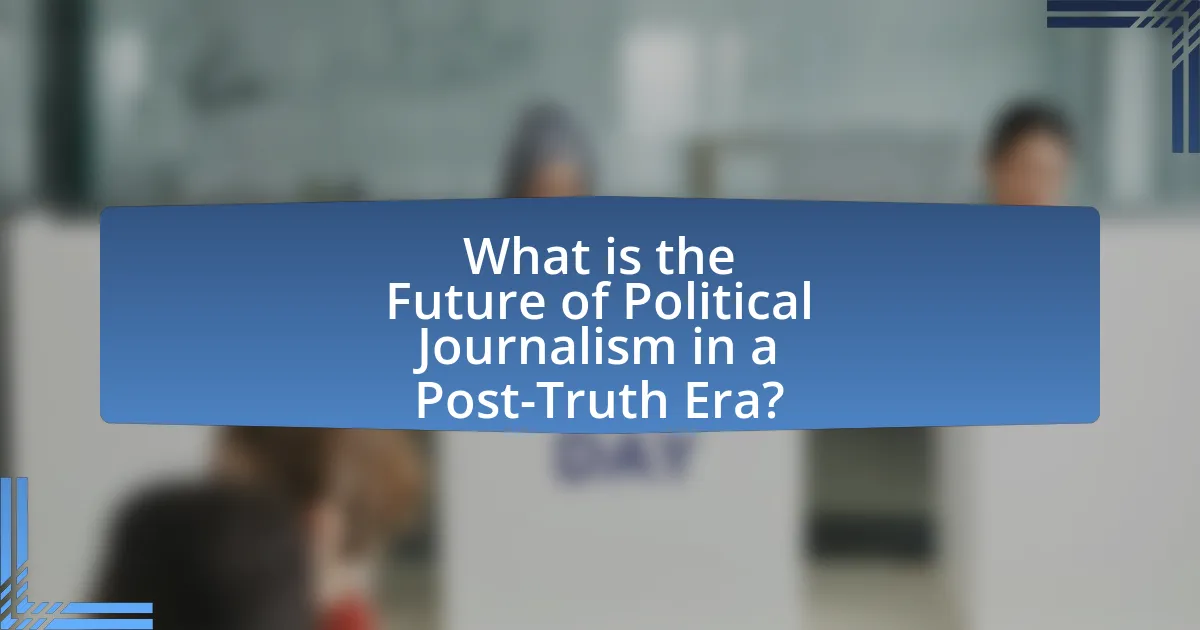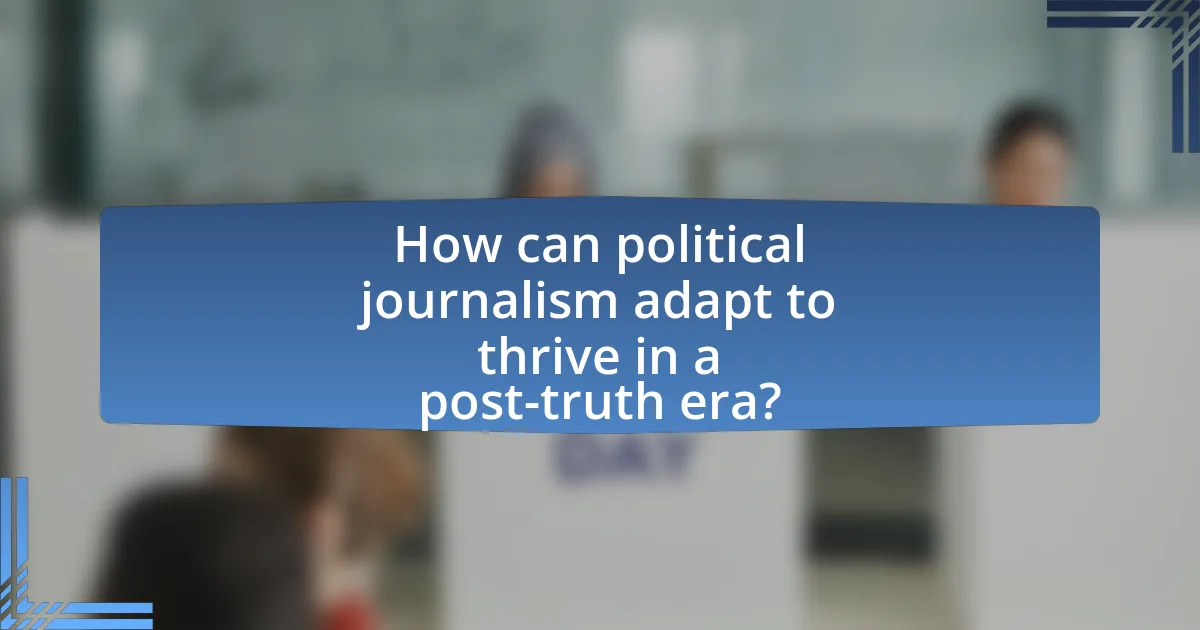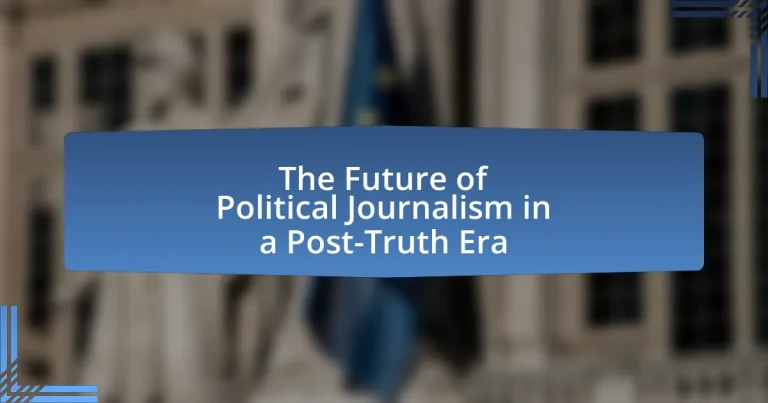The article examines the future of political journalism in a post-truth era, highlighting the increasing importance of fact-checking, transparency, and audience engagement in combating misinformation. It discusses the evolution of political journalism due to digital media, the rise of partisan reporting, and the challenges posed by misinformation, which has led to a decline in public trust in traditional media. Key features of this landscape include the need for journalists to navigate ethical dilemmas, utilize innovative strategies for accuracy, and foster critical thinking among audiences to maintain credibility and effectively inform the public.

What is the Future of Political Journalism in a Post-Truth Era?
The future of political journalism in a post-truth era will increasingly focus on fact-checking, transparency, and audience engagement. As misinformation proliferates, journalists will prioritize verifying information before publication, utilizing tools and technologies to enhance accuracy. For instance, organizations like PolitiFact and FactCheck.org have gained prominence by providing rigorous fact-checking services, reflecting a growing demand for accountability in reporting. Additionally, the integration of audience feedback mechanisms will allow journalists to adapt their narratives based on public concerns, fostering trust and credibility. This shift is essential as studies indicate that trust in media has declined, with a 2021 Pew Research Center survey showing that only 29% of Americans trust the news they consume. Thus, the evolution of political journalism will hinge on its ability to combat misinformation while maintaining public trust through transparency and engagement.
How has the concept of political journalism evolved in recent years?
The concept of political journalism has evolved significantly in recent years, primarily due to the rise of digital media and the increasing prevalence of misinformation. Traditional political journalism, which relied on established news outlets and fact-checking, has shifted towards a more fragmented landscape where social media platforms play a crucial role in shaping public discourse. This evolution is evidenced by the growing number of independent journalists and citizen reporters who utilize online platforms to disseminate information rapidly, often bypassing traditional editorial standards. Additionally, studies indicate that trust in mainstream media has declined, with a 2021 Pew Research Center survey revealing that only 29% of Americans trust the news they consume, highlighting the challenges political journalism faces in maintaining credibility in a post-truth era.
What are the defining characteristics of political journalism today?
Political journalism today is characterized by its emphasis on digital platforms, the prevalence of partisan reporting, and the challenge of misinformation. Digital platforms have transformed how news is disseminated, with social media playing a crucial role in reaching audiences rapidly. Partisan reporting has increased, as many outlets align with specific political ideologies, influencing public perception and discourse. Additionally, the rise of misinformation complicates the landscape, as journalists must navigate false narratives and verify facts to maintain credibility. These characteristics reflect the evolving nature of political journalism in a complex media environment.
How does the post-truth era influence the perception of political journalism?
The post-truth era significantly alters the perception of political journalism by prioritizing emotional appeal over factual accuracy. In this context, audiences increasingly favor news that aligns with their beliefs, leading to a rise in partisan reporting and the spread of misinformation. Research indicates that during the 2016 U.S. presidential election, for instance, false information was shared more widely on social media than factual news, illustrating how emotional resonance can overshadow journalistic integrity. This shift challenges traditional journalistic standards and fosters skepticism towards media sources, as audiences question the objectivity and reliability of reporting in an environment where truth is often subjective.
Why is understanding the post-truth era crucial for political journalism?
Understanding the post-truth era is crucial for political journalism because it directly impacts the integrity and credibility of news reporting. In this era, emotional appeal and personal beliefs often outweigh objective facts, leading to misinformation and public distrust in media sources. Research indicates that during the 2016 U.S. presidential election, for instance, false information spread rapidly on social media, influencing voter perceptions and decisions. This highlights the necessity for political journalists to critically evaluate sources, fact-check claims, and provide context to counteract the effects of misinformation. By doing so, they can uphold journalistic standards and foster informed public discourse.
What are the key features of the post-truth era?
The key features of the post-truth era include the prioritization of emotional appeal over factual accuracy, the proliferation of misinformation, and the erosion of trust in traditional media sources. In this context, emotional narratives often overshadow objective facts, leading individuals to form beliefs based on personal feelings rather than empirical evidence. The rise of social media platforms has facilitated the rapid spread of misinformation, making it easier for false narratives to gain traction. Additionally, public skepticism towards established media institutions has increased, as audiences increasingly turn to alternative sources that align with their pre-existing beliefs, further contributing to a fragmented information landscape.
How does misinformation impact political discourse?
Misinformation significantly distorts political discourse by shaping public perception and influencing voter behavior. It creates confusion and polarization among the electorate, leading to a misinformed citizenry that struggles to engage in constructive dialogue. For instance, a study by the Pew Research Center found that 64% of Americans believe that misinformation has a major impact on their understanding of political issues. This distortion undermines trust in legitimate news sources and institutions, further complicating the landscape of political communication.

What challenges does political journalism face in a post-truth environment?
Political journalism faces significant challenges in a post-truth environment, primarily due to the prevalence of misinformation and the erosion of trust in traditional media sources. The rise of social media platforms has facilitated the rapid spread of false narratives, making it difficult for journalists to verify facts and maintain credibility. According to a 2020 study by the Pew Research Center, 53% of Americans believe that news organizations intentionally mislead the public, highlighting the skepticism towards media outlets. Additionally, the pressure to produce content quickly often compromises journalistic standards, leading to the dissemination of unverified information. These factors collectively undermine the role of political journalism in providing accurate and reliable information to the public.
How does the rise of social media affect political journalism?
The rise of social media significantly transforms political journalism by enabling faster dissemination of information and increasing audience engagement. Social media platforms allow journalists to share news instantly, reaching a broader audience compared to traditional media outlets. According to a Pew Research Center study, 62% of Americans get news from social media, highlighting its role as a primary news source. This shift also leads to challenges, such as the spread of misinformation, as unverified content can go viral quickly, complicating the journalist’s role in verifying facts. Furthermore, social media encourages direct interaction between journalists and the public, fostering a more participatory form of journalism but also blurring the lines between professional reporting and personal opinion.
What role does social media play in spreading misinformation?
Social media significantly contributes to the spread of misinformation by enabling rapid dissemination of false information to a vast audience. Platforms like Facebook and Twitter allow users to share content instantly, often without verification, leading to the viral spread of misleading narratives. A study by the Massachusetts Institute of Technology found that false news stories are 70% more likely to be retweeted than true stories, highlighting the platform’s role in amplifying misinformation. Additionally, algorithms prioritize engagement over accuracy, further exacerbating the issue by promoting sensational content that may not be factual.
How can journalists navigate the challenges posed by social media?
Journalists can navigate the challenges posed by social media by implementing rigorous fact-checking processes and maintaining transparency with their audience. Fact-checking helps to counter misinformation, which is prevalent on social media platforms; for instance, a study by the Pew Research Center found that 64% of Americans believe that misinformation is a major problem in the news. Additionally, transparency fosters trust, as journalists who openly share their sources and methods are more likely to engage their audience effectively. By combining these strategies, journalists can enhance their credibility and combat the negative impacts of social media on political journalism.
What ethical dilemmas arise for journalists in a post-truth era?
Journalists face significant ethical dilemmas in a post-truth era, primarily revolving around the challenges of misinformation, objectivity, and accountability. The prevalence of false information complicates the journalist’s duty to report accurately, as they must navigate a landscape where facts are often overshadowed by emotional appeals and subjective narratives. This environment pressures journalists to balance the need for sensationalism to attract audiences with their ethical obligation to provide truthful reporting.
Moreover, the rise of social media as a primary news source exacerbates these dilemmas, as journalists must contend with the rapid spread of unverified information, which can lead to public distrust in legitimate news sources. A study by the Pew Research Center in 2020 indicated that 53% of Americans believe that news organizations intentionally mislead the public, highlighting the erosion of trust that journalists must work to rebuild.
Additionally, journalists grapple with the ethical implications of their role in shaping public discourse, as their reporting can influence political polarization and societal divisions. The challenge lies in maintaining integrity while engaging with audiences that may prioritize confirmation bias over factual accuracy.
How do journalists balance truth and audience engagement?
Journalists balance truth and audience engagement by prioritizing factual reporting while employing engaging storytelling techniques. They utilize data-driven journalism to ensure accuracy, as seen in the rise of fact-checking organizations that verify claims made by public figures, thereby reinforcing credibility. Simultaneously, they craft narratives that resonate with audiences, using relatable language and compelling visuals to maintain interest. This dual approach is essential in a post-truth era, where misinformation is prevalent; for instance, a study by the Pew Research Center found that 64% of Americans believe that fabricated news stories cause confusion about basic facts. By integrating rigorous fact-checking with engaging content, journalists can effectively inform and captivate their audience.
What responsibilities do journalists have in combating misinformation?
Journalists have the responsibility to verify information before publication to combat misinformation. This includes fact-checking sources, cross-referencing data, and ensuring the accuracy of claims made in their reporting. According to the American Press Institute, rigorous fact-checking can significantly reduce the spread of false information, as seen in studies showing that misinformation can be corrected effectively when journalists provide clear, evidence-based reporting. Additionally, journalists must educate the public about media literacy, helping audiences discern credible sources from unreliable ones, which is crucial in a post-truth era where misinformation proliferates rapidly.

How can political journalism adapt to thrive in a post-truth era?
Political journalism can adapt to thrive in a post-truth era by prioritizing fact-checking, transparency, and audience engagement. Fact-checking organizations, such as PolitiFact and FactCheck.org, have demonstrated that rigorous verification of claims can enhance credibility and trust among readers. Transparency in sourcing and methodology allows journalists to build rapport with audiences, fostering a more informed public. Additionally, engaging with audiences through social media platforms can facilitate dialogue and address misinformation directly, as seen in initiatives by news outlets that encourage user-generated content and feedback. These strategies collectively empower political journalism to navigate the complexities of a post-truth landscape effectively.
What innovative strategies can journalists employ to ensure accuracy?
Journalists can employ data verification tools and collaborative fact-checking networks to ensure accuracy. Utilizing platforms like ClaimReview and tools such as Google Fact Check Explorer allows journalists to cross-reference claims with verified data sources. Additionally, collaborating with organizations like the International Fact-Checking Network enhances credibility, as these networks provide resources and support for rigorous fact-checking processes. Research indicates that news organizations that adopt these strategies significantly reduce misinformation, thereby improving public trust and the overall quality of journalism in a post-truth era.
How can fact-checking become a core component of political journalism?
Fact-checking can become a core component of political journalism by systematically verifying claims made by politicians and public figures, thereby enhancing accountability and trust. This process involves journalists employing rigorous methodologies to assess the accuracy of statements, utilizing credible sources and data to substantiate their findings. For instance, organizations like PolitiFact and FactCheck.org have established standards for evaluating claims, which can serve as models for integrating fact-checking into daily reporting practices. By prioritizing fact-checking, political journalism can combat misinformation, as evidenced by studies showing that fact-checking reduces the spread of false information and increases public awareness of factual discrepancies.
What role does transparency play in rebuilding trust with audiences?
Transparency is crucial in rebuilding trust with audiences as it fosters accountability and openness. When organizations openly share information about their processes, decisions, and potential conflicts of interest, they demonstrate a commitment to honesty, which can counteract skepticism. Research indicates that 81% of consumers need to trust a brand before making a purchase, highlighting the importance of transparency in establishing credibility. Furthermore, transparency allows audiences to verify claims independently, reinforcing their trust in the information presented. In the context of political journalism, where misinformation is prevalent, transparent practices can significantly enhance the perceived integrity of news sources, ultimately leading to stronger audience relationships.
How can collaboration enhance the effectiveness of political journalism?
Collaboration can enhance the effectiveness of political journalism by pooling resources, expertise, and diverse perspectives, which leads to more comprehensive and accurate reporting. When journalists from different outlets or disciplines work together, they can share data, conduct joint investigations, and cross-verify information, thereby reducing the likelihood of misinformation. For instance, collaborative projects like the Panama Papers, which involved over 370 journalists from various countries, demonstrated how teamwork can uncover significant political corruption and provide a more nuanced understanding of complex issues. This collective effort not only amplifies the reach of the findings but also fosters greater accountability in political reporting.
What partnerships can journalists form to combat misinformation?
Journalists can form partnerships with fact-checking organizations, technology companies, and academic institutions to combat misinformation. Collaborating with fact-checkers allows journalists to verify claims and provide accurate information to their audiences, as seen in initiatives like the International Fact-Checking Network, which promotes transparency and accountability in reporting. Partnering with technology companies enables journalists to leverage algorithms and tools that identify and flag false information, exemplified by collaborations with platforms like Facebook and Google to enhance content accuracy. Additionally, working with academic institutions can facilitate research on misinformation trends and effective communication strategies, as demonstrated by studies from institutions like the Pew Research Center, which provide valuable insights into public perception and misinformation dynamics.
How can cross-disciplinary approaches improve political reporting?
Cross-disciplinary approaches can improve political reporting by integrating insights from various fields such as sociology, psychology, and data science. This integration allows journalists to better understand the social dynamics and psychological factors influencing public opinion and political behavior. For instance, incorporating data analytics can enhance the accuracy of reporting by identifying trends and patterns in voter behavior, as evidenced by the use of big data in the 2016 U.S. presidential election, which helped campaigns tailor their messages effectively. Additionally, insights from sociology can provide context on how cultural factors shape political narratives, leading to more nuanced reporting that reflects the complexities of contemporary political issues.
What practical steps can journalists take to engage audiences effectively?
Journalists can engage audiences effectively by utilizing interactive storytelling techniques. This approach allows journalists to create immersive experiences that encourage audience participation, such as polls, quizzes, and comment sections, which foster a sense of community and investment in the content. Research indicates that interactive content can increase user engagement by up to 300%, demonstrating its effectiveness in capturing audience attention and enhancing retention of information. By incorporating multimedia elements like videos, infographics, and social media integration, journalists can cater to diverse audience preferences, making the information more accessible and appealing.
How can journalists utilize storytelling to convey complex political issues?
Journalists can utilize storytelling to convey complex political issues by framing narratives that humanize the subject matter and make it relatable to the audience. This approach allows journalists to break down intricate topics into digestible segments, using characters, conflicts, and resolutions that resonate with readers. For instance, the use of personal anecdotes or case studies can illustrate the real-world impact of policies, making abstract concepts more tangible. Research indicates that stories are more memorable than facts alone; a study by the Stanford Graduate School of Business found that narratives can increase information retention by up to 22 times. By employing storytelling techniques, journalists can effectively engage their audience, fostering a deeper understanding of political complexities in a post-truth era.
What techniques can be used to foster critical thinking among readers?
Techniques to foster critical thinking among readers include encouraging questioning, promoting diverse perspectives, and utilizing evidence-based reasoning. Encouraging questioning involves prompting readers to ask why and how, which stimulates deeper analysis of information. Promoting diverse perspectives allows readers to consider multiple viewpoints, enhancing their ability to evaluate arguments critically. Utilizing evidence-based reasoning requires readers to assess the validity of claims through data and research, reinforcing the importance of substantiated information. These techniques are supported by educational research indicating that active engagement and exposure to varied viewpoints significantly improve critical thinking skills.


